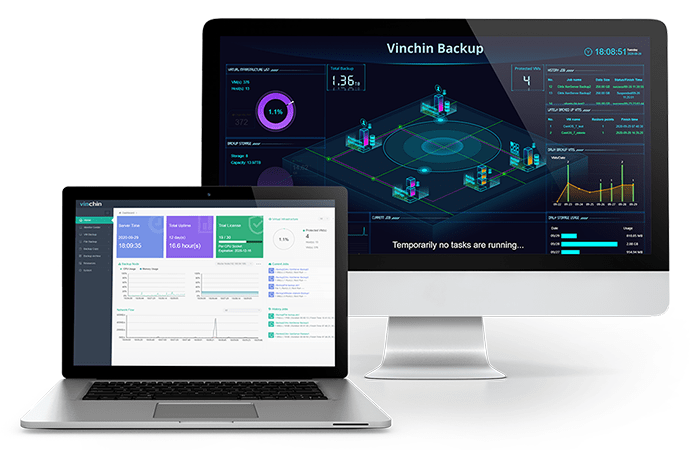-
What is VM sprawl?
-
Impact on VM sprawl to business system
-
How to prevent VM sprawl?
-
How to backup VM with Vinchin Backup & Recovery?
-
Sum Up
Virtualization has brought much convenience in company. With the easy deployment of VM, IT environment never ever becomes so flexible and the power of server gets fully released. The staff can have more machines to use but amazingly the IT cost gets reduced because one physical server can be used as multiple VMs.
However, does virtualization brings only convenience?
What is VM sprawl?
VM sprawl means there are too many VMs in IT environment to manage for IT administrator and it can be caused by creating too many VMs or allocating too many hardware resources to certain VMs.
As mentioned before, VM is very easy to create for every company but not every company has a good method for later VM management. In fact, VM sprawl has become a common issue in virtual environment.
The mature virtualization technology makes VM deployment so easy especially after VM deployment is automated. VM sprawl is easy to appear before company would like to archive and delete VMs in virtual environment.
If there are no proper procedures for creating VM, everyone can create VM without approval and the VM might be forgotten after being used once. If there is no description on the VM, it will be hard for IT administrators to judge whether the VM is crucial to business system.
Impact on VM sprawl to business system
VM sprawl might not look like a severe problem in IT environment. Just too many virtual machines. What’s wrong? In fact, VM sprawl can be a severe problem if you don’t pay attention to it before it’s too late because VM sprawl will weaken the advantages of virtualization little by little.
Data security issue
If the VM is left with sensitive data and no one values the VM, there might be the risk of data leakage.
VM performance issue
There are many VMs running on one host and they are sharing the hardware resources of the host. When the VM is running but does nothing to the business systems, it is totally a waste of the hardware resources like CPU and memory. Even though the useless VM is no longer booted, it is still consuming the storage of datastore. This will directly influence the performance of the other VMs on the host.
More management work
More VMs on the host means more maintenance work for IT administrators. If the VM is useless but IT administrator still updates and patches it in daily work, it is totally a waste of human resources and it will also cause more unnecessary work later.
More cost
If you don’t delete the useless VM or adjust the VM configuration, the hardware resources will be gradually used up, and you need to procure new physical server.
In addition, if the VM is licensed to some software, the license will be wasted, too.
How to prevent VM sprawl?
To avoid reviewing the virtual environment with sweats, you can do something to prevent VM sprawl.
VM lifecycle management
You should compile a document for standardizing VM management including the creating process, maintaining methods, retirement requirements, etc. It will let the VM properly retire rather than stay on the host when it is the end of its life.
Monitor hardware resources utilization
The hardware resources of the host should be monitored to know whether the VMs are vying for hardware resources. If you find VM sprawl, you can shut down the impractical VMs or move VM between different hosts for load balancing.
Describe the VM
When VM is created, there should be a description on the VM to show the purpose of creating this VM and it will be better to add the owner of VM there to let you contact him.
Tags also can be added to VMs to let you better group the VMs. If there is no tag, there should be at least folders to store different VMs.
Archive the VM
There might be an ownerless VM on the host but you don’t know whether you should delete it or not. If so, you can simply archive the VM like exporting VM to another datastore. If it is needed later, you can directly import it back.
If the VM is definitely useless, you can simply delete it.
How to backup VM with Vinchin Backup & Recovery?
In case of any data loss, you can use Vinchin Backup & Recovery, a professional backup and disaster recovery solution, to backup data in virtual environment like VMware vSphere, Hyper-V, XenServer, XCP-ng, RHV/oVirt, OLVM, OpenStack, etc.

There will be a user-friendly web console to help you build a highly efficient backup system. Try it with a 60-day full-featured free trial.
Vinchin Backup & Recovery has been selected by thousands of companies and you can also start to use this powerful system with a 60-day full-featured free trial. Just click the button to get the installation package.
Sum Up
Virtualization can bring convenience to company but also the trouble. Because it is too easy to create a VM, there might be VM sprawl issue and it makes IT administrators not be able to manage too many VMs.
You can make preparation for VM sprawl by compiling related document, monitoring hardware resource usage, etc.
To avoid any data loss in virtual environment, you can try Vinchin Backup & Recovery. Don’t miss the free trial.
Share on:








